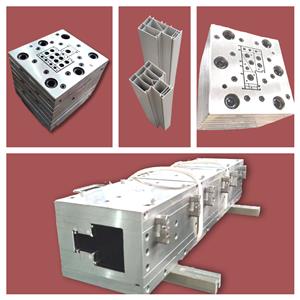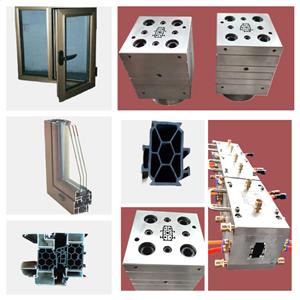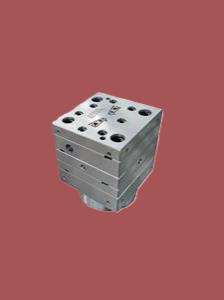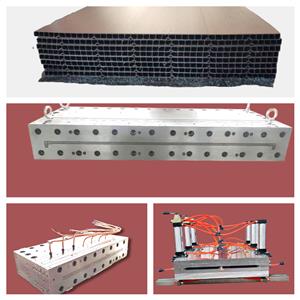پلاستیک پی وی سی، ساخت قالب اکستروژن، حجاب را برای شما رونمایی می کند
معمولاً دو شکل از قالب ها استفاده می شود: قالب های پلکانی صفحه ای و قالب های گرادیان مقطعی. مسیر جریان قالب پلکانی صفحه به صورت پله ای تغییر می کند که از چندین قالب دهانه به صورت سری ساخته شده است. هر صفحه به شکل کانتور مربوطه ماشینکاری می شود که به تدریج از شکل گرد ورودی به شکل خروجی مورد نظر تغییر می کند. در ورودی هر بلوک مورب هایی وجود دارد تا انتقال از یک شکل به شکل دیگر تکمیل شود. این نوع از هزینه پردازش قالب کم است، کانال جریان ایده آل نیست و به طور کلی نیازی به استفاده به عنوان نمایه اصلی ندارد. رانر قالب گرادیان مقطع کارآمد است، هیچ منطقه نگهداری از مواد در رانر وجود ندارد، مذاب به تدریج و با دقت به هر بخش از شکل خروجی از دایره در ورودی توزیع می شود و سرعت به طور پیوسته به سرعت افزایش می یابد. سرعت خروجی مورد نیاز، و سرعت هر نقطه در بخش یکسان است. برای پروفیل های پلاستیکی پی وی سی با هسته های قالب پیچیده، هسته قالب یا با صفحه براکت یکپارچه می شود، برخی از آنها با قرار دادن پین ها و پیچ ها به صفحه براکت ثابت می شوند، و برخی نیز با منبت کاری محکم بر روی صفحه براکت تعبیه می شوند. در حین استفاده نمی توان آن را به راحتی جدا کرد، زیرا مونتاژ مجدد و اشکال زدایی زمان بر است. شنت مذاب نیز به دو صورت انجام می شود: روی مخروط شنت و در قسمت فشرده سازی. از قالب گرادیان مقطع می توان به عنوان قالب پروفیل اصلی استفاده کرد. قالب اکستروژن پروفیل پلاستیک پی وی سی بخش اصلی خط تولید اکستروژن است که شامل قالب دهان (همچنین به عنوان سر قالب شناخته می شود)، قالب شکل دهنده، مخزن آب خنک کننده و غیره است. قالب دهان با فلنج روی سر اکسترودر به وسیله ابزاری مونتاژ می شود. از یک فلنج، و حلقه گرمایش، صفحه گرمایش، منبع تغذیه و ترموکوپل متصل هستند. قالب شکل دهنده و مخزن آب خنک کننده با پیچ به میز شکل دهی ثابت می شود و لوله آب و لوله گاز وصل می شود. ساختار اصلی قالب اکستروژن به طور کلی به عنوان ساختاری از قالب های متعدد روی هم چیده شده و مونتاژ شده طراحی می شود. بنابراین، کانال جریان کل قالب با اتصال یکی از کانال های جریان در هر قطعه از قالب، جلو و عقب تشکیل می شود. صفحه ورق با پین و پیچ و مهره قرار گرفته و محکم می شود تا یک قالب اکستروژن یکپارچه تشکیل شود. وضعیت اصلی این است: بخش جریان ثابت قالب اکستروژن اغلب از یک صفحه سوراخ دار و نیمه جلوی گردن تشکیل شده است و نیمه جلویی و نیمه دوم گردن نیز به عنوان دو قالب طراحی شده اند، گردن و گردن. صفحه انتقال گردن همچنین می توان از صفحه متخلخل استفاده نکرد، بلکه نیمه جلوی کانال جریان گردن را به صورت یک کانال جریان استوانه ای برای تثبیت جریان طراحی کرد. بخش تقسیم قالب اکستروژن از نیمه دوم گردن شروع می شود و شامل مخروط شکاف، صفحه براکت تقسیم شده و صفحه جمع شدگی است. صفحه انقباض را می توان نه به یک قالب واحد، بلکه همراه با صفحه پیش ساخته - یک قالب تقسیم کرد. بخش شکل دهی قالب اکستروژن شامل قالب های زیر است: صفحه حفره (همچنین به عنوان صفحه پیش ساخته نیز شناخته می شود)، قالب دهان (همچنین به عنوان صفحه شکل دهنده نیز شناخته می شود) و هسته (همچنین به عنوان هسته قالب نیز شناخته می شود). برای قالبهای سادهتر پروفیل، صفحه از پیش ساخته شده با قالب دهانی در یک قالب ترکیب میشود. 1. نکات کلیدی طراحی سطح مقطع محصول نکته کلیدی طراحی محصول پروفیل پلاستیکی پی وی سی این است که ضخامت و شکل هر بخش باید به طور متقارن توزیع شود، به طوری که جریان مواد در سر دستگاه متعادل شود، خنک کننده می تواند یکنواخت باشد. ، و فشار تمایل به متعادل شدن دارد. به طور کلی، حداکثر ضخامت دیوار و حداقل ضخامت دیواره یک بخش متفاوت است < 50% is appropriate. If it is a part of a closed rib, the thickness of the rib should be 20% thinner than the wall thickness. In order to avoid the stress concentration at the corner of PVC plastic profile products, the shape change of the product should be smooth and smooth transition, generally the outer corner R is not less than 0.5mm, the inner corner R is not less than 0.25mm. The hollow part of the product should not be too small. The cross-sectional shape is preferably symmetrical. 2. Structure type and design principle of mold The mold is the forming part of the extruder, which is mainly composed of neck seat, shunt cone, support plate (also known as bracket), core mold, mouth template and adjusting screw. PVC plastic profile extrusion die county is mainly composed of three sections: feeding section one by machine base and distribution cone composed of machine head flow channel feeding section, is conical: melt distribution and forming section one by support plate and mouth die compression part constitute melt distribution and forming section, the shape is gradually close to the PVC plastic profile section, parallel section mouth die and core die constitute the machine head parallel section, (1) There are two types of mold structure for extruded plastic profiles: plate head and streamlined head. According to the different methods of processing and manufacturing the machine head, the streamlined head fork is divided into integral streamlined and segmented (also known as stepped) streamlined. (2) Mold design principle The mold is the key part of PVC plastic profile extrusion, and its function is to extrude a blank similar to the profile under the action of 10~25MPa extrusion force. PVC plastic profile mold runner design principle is that the runner section should be streamlined: there is enough compression ratio and shaped length to form a certain extrusion pressure: the flow resistance balance and flow symmetry of the cross-sectional gap of each runner part of the mold. The flow channel structure of the PVC plastic profile head is generally divided into three parts: feeding, compression (also known as transition part) and forming. Generally speaking, the length of the feed part of the long runner is 1 of the length of the shaping part. About 5~2 times, the length of the compression part is about 2~3 times the length of the shaping part. The maximum cross-sectional area of the compression section is in the outlet area of the bracket. The shape of the support ribs of the bracketer. The broad one is jujube nucleus-shaped. The thin ones are long prismatic. The shape of the divergence in the front of the scaffold is that it converges at the same angle on all sides, forming a torpedo body shape. The flow rate of molten material is different in the flow channel of feeding, compression and forming, the feeding part is the smallest, the forming part is the largest, and the transition part must be in between the two and gradually increase in the direction of extrusion. The melt flow rate is inversely proportional to the cross-sectional area of the runner. The roughness of the runner in the head should be Ra0. 4~0.8ym, the roughness of the mouth mold runner of the stereotyped part is higher than the roughness of the inner runner, which should be Ra0.2~0. 4μm, When the extruded billet is just exported to the die, the size of the gap is increased than the mouth die, which is called the mold release expansion, that is, the Balas effect. This effect must be considered when the pulling speed of PVC plastic profile extrusion is slow and it is cooled near the outlet of the die mold. The release mold expansion of the outlet die is usually calculated by volume, and its expansion rate is generally 1.5~2.5 times, and this value changes with different aspects of melt temperature, pressure and velocity. The wall thickness size required for PVC plastic profiles depends on the wall thickness of the appropriate extruded billet on the one hand, and the pulling speed and extrusion amount on the other hand. The thickness of the extrusion blank wall mainly depends on the size of the mouth die gap, and then depends on the plasticizing performance of the material in the extruder, extrusion pressure, extrusion temperature, material performance and expansion value. First, the standard traction shrinkage rate for general wall thickness is ≤2.5%. The gap between the mouth die and the thickness of the product are taken (0.8~0.9) 1 1




